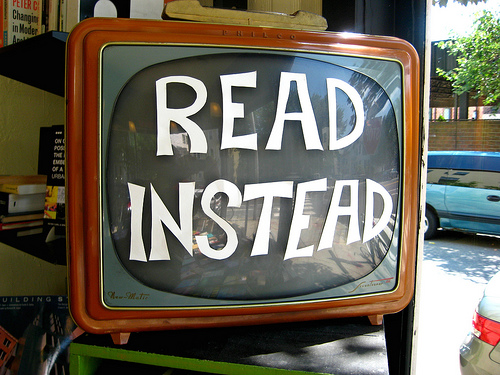You are here
Using TV Tropes to Teach Narrative Devices
Primary tabs

"Multimedia Message" by rockcreek via Flickr
Incorporating TV Tropes (a wiki that catalogues narrative devices used across a variety of media) into your discussion of literary devices and encouraging students to talk about how narrative techniques across different genres and forms of media can assist in making these concepts intelligible and "real" to them.
To teach students how to identify and assess the literary tropes or narrative techniques an author is using and to recognize how those devices are manipulated across genres. It can also be useful for rhetorical analysis and invention.
Just a computer with an internet browser. In the enhanced version of this assignment, students will create their own wiki, which will be very easy to do if you already use a site like PBWorks for your class.
Instructors attempting to teach students to analyze the formal qualities of a work will often introduce literary devices and tropes into their students' lexicons. Students, however, often have difficulty assimilating these concepts as anything more than items to be found and labelled in any given narrative work. They have difficulty understanding why authors do the things they do and what affects the author's choices may be having on their expectations as readers.
TV Tropes is a wiki that catalogues narrative devices used across a variety of media: literature, television, film, manga, comic books, video games, etc. It is rigorously maintained by careful amateur observers of modern media, is often cited on fan websites, and is evidence that Formalism exists on the internet. John Crowe Ransom would be proud.
Incorporating TV Tropes into your discussion of literary devices and encouraging students to talk about how narrative techniques across different genres and forms of media can assist in making these concepts intelligible and "real" to them.
This idea originally emerged from a conversation with a student who wrote a paper comparing the video game Dante's Inferno to the original poem. His observations about the changes in the story led to a productive discussion about the narrative demands of video games vs. medieval poetry.
Spend 10-20 minutes introducing your students to TV Tropes. Give them some time to learn how to navigate the site and read a few entries. If you have a few key literary devices that you would like them to learn, you might direct them to those pages or create a list of major tropes you want them to look at on their own time.
Prepare a short reading assignment. Short stories work great for this. You may wish to choose something that doesn't already have its own page on TV Tropes. The inspiration for this assignment began with a short reading from Dante's Inferno.
Have students take a reading home and see how many devices they can identify. Have them note examples in the text and be prepared to talk about where they see that technique, why the author may be using it, and what affect it has on them as a reader. I had students use this as a journal prompt. Encourage them to get beyond "like" and "dislike" (the TV Tropes editors are insist that their entries remain value neutral, that the use of a device does not make a particular narrative work good or bad). Instead, have them talk about how the use of a technique met or subverted their expectations, how the characters were developed, etc. They can make reference to the website's other examples of how that trope is used in other narratives or forms of media.
This assignment was not graded.
This basic assignment works great as a jumping off point for guided journaling/reflection and in-class discussion, but some instructors may wish to take it to the next level. Next semester, I will have students create a wiki page on our PBWorks site for a reading that doesn't already have it's own page on TV Tropes. While the Divine Comedy page on their site is already quite extensive, a short work like "Young Goodman Brown," which I've been teaching for a long time now, could work very well for a collaborative wiki project like this.
This was initially used in an introductory literary studies course - E314J Literature and Religion.
The figure of the Devil has inspired myriad artistic representations that reveal and inform the way we understand the source of ultimate evil and suffering—as a rebellious angel forever tormented by his separation from God, as a malevolent force in competition with a benevolent deity, as a trickster figure sparking mischief and mayhem, or as a motiveless malignity bent on causing pain and suffering wherever possible. This course will consist of an historical survey of literary representations of the Devil in the Western religious traditions, beginning with Marlowe’s depiction of the Faustian bargain and Milton’s fallen angel as epic hero, taking us into the present day. We will end with Salman Rushdie’s exploration of the angel/devil dichotomy in the context of globalization and religious extremism, considering how contemporary discussions of fundamentalism and terrorism have shaped our modern understanding of evil.
-

- Log in to post comments

